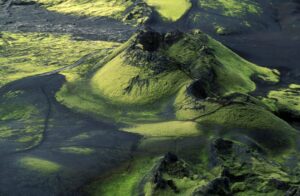Port Royal was a city on a sand spit in the harbor of Jamaica, Kingston. It was hit with an earthquake and tsunami and the whole city sank into the ocean.
On June 7, 1692, Port Royal, Jamaica, experienced a powerful earthquake and a tsunami. Larger houses collapsed almost immediately and smaller ones slid off the land into the harbor as a widespread state of liquefaction dislocated their sandy foundations. Before the end of the day most of the city had disappeared beneath the waters of Kingston Harbor. Most of those who were left standing in the midst of all the destruction were swept into the sea by the tsunami. Two thousand were killed immediately and an additional two thousand died later from injuries or disease. The city’s graveyard was a victim of the earthquake so the survivors, as they sought to recover some of their possessions, had to cope with a frightening scene. There were coffins and bodies from the graveyard floating around along with those who had just been killed. As they continued their search they had to fight against a group of thieves who were taking advantage of the chaotic situation.
Few people seeing modern day Port Royal, Jamaica, a small isolated fishing village at the tip of a sand spit that extends into Kingston Harbor for about eighteen miles, would ever think that it once played a major role in the politics of the Caribbean and England. All the evidence now lies beneath the water of Kingston Harbor. Port Royal is the only sunken city in the western hemisphere. Founded soon after the conquest of the island of Jamaica from the Spanish by an English invasion force in 1655, Port Royal went through a spectacular rise in wealth and influence. Just before the earthquake it was the largest English town in the New World, and the most affluent. Every visitor was impressed with the multistoried brick buildings, quite a contrast to other English colonial towns in the New World. It had a population of more than seven thousand and rivaled Boston in size and economic power, the only other city of comparable importance at that time.
The English turned Port Royal into a strategic military and naval base. Its location in the middle of the Caribbean made it ideal for trade. Trade, as well as loot, dominated the economy in those times. The European powers extracted wealth from their colonies and brought it back to Europe in ships. If a country happened to have a powerful naval force it was considered fair game to raid the ships of other countries and empty their cargos of gold and other valuables. England was one country that engaged in that kind of enterprise. During its heyday, Port Royal was laid out with broad unpaved streets, named after familiar streets in London, each lined with buildings ranging in height from one to four stories. There were several sidewalks lined with bricks and rents ran as high as the highest found anywhere in London, maybe because London was still recovering from a devastating fire and an equally destructive plague. Port Royal in 1692 occupied a space of more than fifty acres at the western tip if the sand spit that extended out from Kingston Harbor, and after the earthquake only twenty of those acres were still above water. It was a little different on parts of the spit nearer to shore. Their underlying foundations of coral, below a hundred feet of unconsolidated sand, seemed to be more solid. Those who started running toward the shore at the first indication of an earthquake were saved.
The tsunamis that caused so much trouble came from submarine landslides. The various movements in the faults around the harbor of Kingston occurred horizontally, as strike-slip actions. There were no vertical displacements. The powerful earthquake created spaces for these landslides and the five-foot tsunami that ensued, mainly inside the harbor area between the peninsula and the main part of the island, swept more than twenty vessels off their moorings and sunk them into the harbor. At the same time, Port Royal was overwhelmed by the same tsunami and most of it sank into deep water to remain submerged for more than two centuries, providing scientists today with a well-preserved record of an early settlement. A brass watch that was recovered in later years appeared to have stopped at 11:43 and archeologists wondered if that represented the exact time of the earthquake. For earthquakes like the one of 1692, the return period lies between two hundred and five hundred years. Hence, a repeat of a similar earthquake and tsunamis could occur at any time. The experiences of those who were still standing after the disaster, mainly by holding on to a branch or pole, provide a useful description of liquefaction. They told of streets rising and falling like waves of the sea. They saw people disappear in the sand and later reappear as stronger waves washed over the streets and carried quantities of sand out to sea. Others that sank into the sand never reappeared. Experiences of this type have often been documented in other earthquakes. Similar events happened in San Francisco in 1906, in Massachusetts in 1755, and more recently in New Orleans in 2005. The reasons for these recurrences are easy to understand.
Unconsolidated stretches of sand, especially these near the sea in major cities, are valuable and suitable sites for building. Either because they did not know of the dangers of liquefaction, or because they did know but were able to persuade authorities to give them permission, construction companies have built large subdivisions on such places, hoping that the next earthquake would not arrive soon. In far too many places it was a false hope. As so often occurs, in the midst of tragedy, there are instances of unexpected courage and generosity. The slave of one master of a ship decided to jump overboard to save his master after he had been swept off his ship into the sea. The slave reached his master and brought him safely back to the ship but then, too exhausted to stay afloat, lost his own life. Slaves were still slaves in 1692 and they were valuable property for those who owned them. In the chaotic situation that followed the earthquake slave owners were afraid that they would either start a revolt or escape—neither happened.
Reconstruction of Port Royal was ultimately a big problem. It had so little land left that everyone wondered how it could continue to carry its former responsibilities. Kingston was not an acceptable alternative for several reasons: it had a high death rate because it was so unhealthy and it was not easily defended if attacked by land and sea simultaneously. Furthermore, since sailing ships were the only kind available in the late seventeenth century, Kingston was not accessible in windy weather. England decided to let both ports, Kingston and Port Royal, share responsibilities for all shipping.
In 1907, a submarine landslide occurred in almost the same location as the one that occurred in 1692. This new submarine landslide generated a tsunami that overwhelmed the peninsula where Port Royal had stood. The earthquake that gave rise to the tsunami caused enormous damage to places all along the shores of Jamaica. At one location, the sea was observed to withdraw as far as three hundred feet within three minutes after the earthquake and to return as a destructive eight-foot wave. The fact that only three minutes elapsed between earthquake and tsunami makes it clear that the landslide happened very close to shore. A pilot and crew of a ship witnessed the return to shore of the tsunami. They saw both the peninsula and the town of Kingston disappear from view for some time. Shortly afterward, seiches as high as eight feet were observed in Kingston Harbor. One thousand people died in the town of Kingston, mainly from falling buildings, and another thousand were injured. Approximately 90,000 were left homeless.
Nothing like seventeenth-century Port Royal remains in that location today. Visitors now see a fishing community of less than 2,000 along with an abandoned British Naval Base, now used by the Jamaican Coast Guard. Jamaica is an independent nation now so the marks of former British activities lie, for the most part, under the sea. The ships and houses that sank in 1692 now form part of a magnificent museum and a unique center for archeological research. On land and sea above all these, in the years since 1692, Jamaica has experienced many more disasters. There was a fire in 1703, completely destroying all that was left or had been rebuilt of the old city of Port Royal. Hurricanes hit it in 1722 and again in 1744 and on both occasions everything came down and had to be rebuilt. Two earthquakes came later, one in 1770 and one in 1907. The former destroyed the hospital and the latter a large part of the dockyard. Another fire, in 1815, did extensive damage to all the buildings, and a third earthquake destroyed the old fortifications.






















1 thought on “Port Royal Earthquake – Jamaica – June 7, 1692”
Spent 8 Months in Port Royal in 1955 as a base for surveying Kingston Bay. Clearly remember snorkeling over a fort 10 foot below the surface and the cannons were still in the battlements